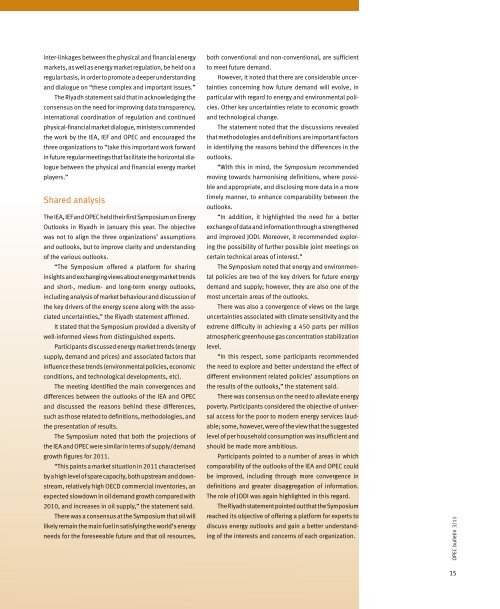OPEC Bulletin January 2009OPEC Bulletin February 2009OPEC ...
OPEC Bulletin January 2009OPEC Bulletin February 2009OPEC ...
OPEC Bulletin January 2009OPEC Bulletin February 2009OPEC ...
You also want an ePaper? Increase the reach of your titles
YUMPU automatically turns print PDFs into web optimized ePapers that Google loves.
inter-linkages between the physical and financial energy<br />
markets, as well as energy market regulation, be held on a<br />
regular basis, in order to promote a deeper understanding<br />
and dialogue on “these complex and important issues.”<br />
The Riyadh statement said that in acknowledging the<br />
consensus on the need for improving data transparency,<br />
international coordination of regulation and continued<br />
physical-financial market dialogue, ministers commended<br />
the work by the IEA, IEF and <strong>OPEC</strong> and encouraged the<br />
three organizations to “take this important work forward<br />
in future regular meetings that facilitate the horizontal dialogue<br />
between the physical and financial energy market<br />
players.”<br />
Shared analysis<br />
The IEA, IEF and <strong>OPEC</strong> held their first Symposium on Energy<br />
Outlooks in Riyadh in <strong>January</strong> this year. The objective<br />
was not to align the three organizations’ assumptions<br />
and outlooks, but to improve clarity and understanding<br />
of the various outlooks.<br />
“The Symposium offered a platform for sharing<br />
insights and exchanging views about energy market trends<br />
and short-, medium- and long-term energy outlooks,<br />
including analysis of market behaviour and discussion of<br />
the key drivers of the energy scene along with the associated<br />
uncertainties,” the Riyadh statement affirmed.<br />
It stated that the Symposium provided a diversity of<br />
well-informed views from distinguished experts.<br />
Participants discussed energy market trends (energy<br />
supply, demand and prices) and associated factors that<br />
influence these trends (environmental policies, economic<br />
conditions, and technological developments, etc).<br />
The meeting identified the main convergences and<br />
differences between the outlooks of the IEA and <strong>OPEC</strong><br />
and discussed the reasons behind these differences,<br />
such as those related to definitions, methodologies, and<br />
the presentation of results.<br />
The Symposium noted that both the projections of<br />
the IEA and <strong>OPEC</strong> were similar in terms of supply/demand<br />
growth figures for 2011.<br />
“This paints a market situation in 2011 characterised<br />
by a high level of spare capacity, both upstream and downstream,<br />
relatively high OECD commercial inventories, an<br />
expected slowdown in oil demand growth compared with<br />
2010, and increases in oil supply,” the statement said.<br />
There was a consensus at the Symposium that oil will<br />
likely remain the main fuel in satisfying the world’s energy<br />
needs for the foreseeable future and that oil resources,<br />
both conventional and non-conventional, are sufficient<br />
to meet future demand.<br />
However, it noted that there are considerable uncertainties<br />
concerning how future demand will evolve, in<br />
particular with regard to energy and environmental policies.<br />
Other key uncertainties relate to economic growth<br />
and technological change.<br />
The statement noted that the discussions revealed<br />
that methodologies and definitions are important factors<br />
in identifying the reasons behind the differences in the<br />
outlooks.<br />
“With this in mind, the Symposium recommended<br />
moving towards harmonising definitions, where possible<br />
and appropriate, and disclosing more data in a more<br />
timely manner, to enhance comparability between the<br />
outlooks.<br />
“In addition, it highlighted the need for a better<br />
exchange of data and information through a strengthened<br />
and improved JODI. Moreover, it recommended exploring<br />
the possibility of further possible joint meetings on<br />
certain technical areas of interest.”<br />
The Symposium noted that energy and environmental<br />
policies are two of the key drivers for future energy<br />
demand and supply; however, they are also one of the<br />
most uncertain areas of the outlooks.<br />
There was also a convergence of views on the large<br />
uncertainties associated with climate sensitivity and the<br />
extreme difficulty in achieving a 450 parts per million<br />
atmospheric greenhouse gas concentration stabilization<br />
level.<br />
“In this respect, some participants recommended<br />
the need to explore and better understand the effect of<br />
different environment related policies’ assumptions on<br />
the results of the outlooks,” the statement said.<br />
There was consensus on the need to alleviate energy<br />
poverty. Participants considered the objective of universal<br />
access for the poor to modern energy services laudable;<br />
some, however, were of the view that the suggested<br />
level of per household consumption was insufficient and<br />
should be made more ambitious.<br />
Participants pointed to a number of areas in which<br />
comparability of the outlooks of the IEA and <strong>OPEC</strong> could<br />
be improved, including through more convergence in<br />
definitions and greater disaggregation of information.<br />
The role of JODI was again highlighted in this regard.<br />
The Riyadh statement pointed out that the Symposium<br />
reached its objective of offering a platform for experts to<br />
discuss energy outlooks and gain a better understanding<br />
of the interests and concerns of each organization.<br />
<strong>OPEC</strong> bulletin 3/11<br />
15

















